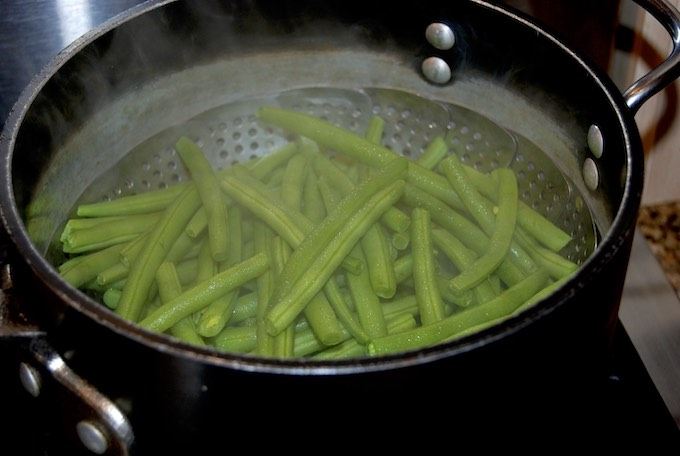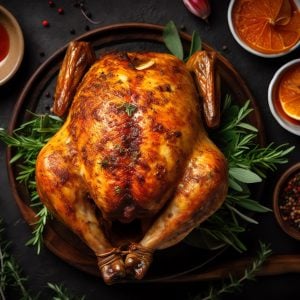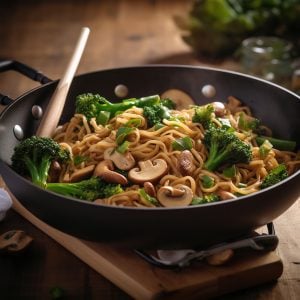How to Steam Foods
Steaming is arguably one of the healthiest ways to cook because no added fat is needed. It is also a very gentle method as foods aren’t knocked around by boiling water or stirred over high heat.
Rather, the steam gently penetrates and cooks all foods at around 212ºF, the boiling point of water. Also, water soluble nutrients are less likely to leach out of foods during steaming than in other moist heat cooking methods, such as poaching or boiling. Unless you are serving the cooking liquid as part of the dish, as in a stew, many nutrients will be poured down the drain along with the liquid.
Almost all types of foods can be steamed including both tender and tough vegetables, dumplings, breads, cakes, meats, fish and grains. While Americans probably think of steaming vegetables and might find it odd to steam other types of foods, people in Asian cultures have a long tradition of steaming dumplings, meats, fish and even buns. As well, the traditional English plum pudding is a steamed cake.
Steaming can be achieved by suspending the food to be cooked above boiling liquid, making sure that the cooking vessel has a tight lid to trap the steam. Food can also be steamed directly in cooking liquid.
While this may seem like boiling or poaching, the difference is that the steamed food – generally grains such as rice or quinoa – will absorb all the liquid, again resulting in minimal loss of nutritional value.
Another big advantage of steaming is a reduced risk of overcooking, since the cooking temperature is low. Steamed foods are more likely to come out consistently moist than with harsher, direct heat cooking methods.
Since steamed foods cook at relatively low temperatures, they will not brown. While you might miss the depth of flavor that the Maillard reactions bring to foods, you will notice the brightness and purity of the flavor of the food itself, which can sometimes be masked by browning.
Steaming appears to be a straightforward process, but as with many cooking methods, there are some pitfalls. I have tried to cover all the mistakes possible, allowing you to avoid them and get perfect results every time.
Most of this list of mistakes and fixes refer to vegetables, what most Americans think of when we think of steaming.
Mistake #1 Using Sub-standard ingredients
You might look in the back of your fridge and notice some broccoli that is a bit past its prime. Not wanting to waste it, you steam it, hoping to salvage your produce. When you serve it, your family is underwhelmed.
The Fix – Use Fresh Ingredients of the Highest Quality you can find
Steaming, perhaps more than any other cooking method, allows the flavor of the food itself to shine through. Steaming intensifies and brightens flavors, so trying to steam an ingredient that is less than fresh is just going to enhance that quality.
The whole idea of steaming is to present a food that is true to itself with minimal flavor enhancers—spices, sauces, etc. So, it pays to use the freshest ingredients you can find. Fresh intensified equals tasty. Not so fresh intensified equals yuck.
Mistake #2 Not Cutting Foods to Uniform Size
Now that you are using the freshest ingredients possible, don’t ruin them by just giving them a rough chop before putting them in the steamer. Cutting foods into uneven pieces, with some being larger and some being smaller, will result in uneven cooking, as it takes longer for heat to penetrate larger pieces of food.
You will either end up with perfectly cooked larger pieces and mushy, overcooked smaller pieces or perfectly cooked smaller pieces with overly crunchy, under-cooked larger pieces. Either way, this is not so great.
The Fix – Keep Foods the Same Size
I am not suggesting you get out your ruler and your scale to make sure that each piece of food has exactly the same mass and dimension, but it is very important to have your foods cut into similar sizes to ensure even cooking. A classically trained chef might square off irregularly shaped pieces of food and then dice them precisely.
For myself, I just make sure that none of the pieces stand out as much larger than (or much smaller than) the other pieces. This holds true for all foods, from dumplings to pieces of fish to chunks of butternut squash to cauliflower. Consistent size leads to consistent results, so now is the time to practice your knife skills.
Mistake #3 Not Waiting for the Water to Boil
I understand that you want to get a weeknight dinner on the table in a hurry. The temptation is to just put the ingredients in the steamer in a cold pan and then heat everything up together. This method just equals more time in the kitchen and, quite possibly, overcooked food.
The Fix—Patience: Wait for the Boil
If you are steaming food suspended over a liquid, as with a steamer basket or a bamboo steamer, very little liquid is needed. After all, you are after the steam, not the liquid, and steam can take up 1600 times the volume of water.
Add to that a lidded cooking vessel which effectively traps the steam, and therefore the liquid, and it becomes obvious that you don’t need much liquid to start with. A couple of ounces is quite probably sufficient to effectively steam most foods, and such a small volume will take very little time to come to a boil anyway.
If you start with your foods in the cold pan, they will begin to cook as the water heats, even before it comes to a boil. You will end up with foods that can be mushy and overcooked on the surface, even if the interior of the food is cooked to perfection.
Mistake #4 Overcrowding the Pan
Now you have your foods cut all in uniform pieces, but you will still encounter problems if you pile too much food into the steamer – you will end up with some pieces that are under – or over-cooked, just as if you hadn’t taken the time to cut the food uniformly in the first place! What gives?
The Fix—Give the Food Some Space
When you boil foods, even if all the pieces aren’t necessarily the same size, the water is turbulent because of the rapid bubbling, and the heat is able to penetrate all the pieces of food.
Steaming is much less dense than water – consider that the same mass of steam takes up 1600 times more space than an equal mass of water – and cooks very gently. There are no bubbles to agitate the food and stir it around.
You’re not stirring the food with a spoon, either, because the cooking pot needs to stay lidded. The steam gently cooks the foods it can “get to.”
If you have piled a bunch of food into your steamer basket, the steam is not going to move the pieces around to get down to the ones in the center of the pile, so make sure your food is not crowded.
Place the food in a shallow layer in the steamer, not in a pile. If you have a bamboo steamer with stack-able inserts, split up large amounts of food in two or even three baskets so the steam is able to penetrate it all the food evenly.

More Steaming Mistakes and How to Avoid Them
Mistake #5 Covering the Pan Loosely
If you think that you are steaming in a vessel without a lid, or just loosely covered with a piece of parchment, you are sadly mistaken. Steam travels in one direction: away from the heat source. This means that, while the food closest to the liquid might get cooked even without a lid, the top surface of the food will remain cold and uncooked.
The Fix—Use a Tight-Fitting Lid
I might be dating myself, but do you remember the old Atari game Pong? The little rectangular “ball” traveled in a straight line until it ricocheted off of the edge of your TV screen.
Think of steam as a bunch of little Atari Pong balls moving in straight lines. They will continue to move in those straight lines, away from the heat source, unless they hit the edge of the TV screen, or in this case, the lid.
Keeping the steam enclosed ensures convection – the hottest steam, the steam closest to the heat source, rises to the lid, cools somewhat as it comes in contact with the metal and then sinks, only to be reheated as it again gets close to the heat source. This rising and falling ensures that the food will be cooked from all sides, including the top.
The tighter-fitting the lid, the more steam is trapped and the more quickly and evenly your food will cook. Of course, there will always be some loss of steam, unless you are using a pressure cooker. You just want to minimize the amount of steam that escapes by using a pan with a tight-fitting lid.
Mistake #6 Overcooking
The difference between crisp tender steamed vegetables and mushy ones might only be a matter of a minute or two, and if you wanted mushy vegetables, you probably wouldn’t be steaming in the first place.
The Fix – Check Your Foods. Also, See Mistakes 2, 3 and 4
If you cut your foods in uniform size, make sure the water is boiling before you add the food and allow adequate space for the steam to penetrate, you will be going a long way towards minimizing the chance of overcooking.
Most recipes you will find for steaming will give a specific amount of time until the food is done, but unless you’ve cut your foods exactly the same size as the recipe and the liquid comes back to a boil in exactly the same amount of time as it did in the test kitchen and you like your foods done exactly the way the recipe author likes theirs done, consider the amount of time a guideline.
Quickly check your food a couple of minutes before the time specified in the recipe, and if it is not done to your liking, put the lid back on quickly to minimize the loss of steam.
Mistake #7 Peeking
While you do want to check your food for doneness after a few minutes, you gain nothing by continually lifting the lid and checking to see what’s happening in that pan.
By peeking, you are losing moisture, and chances are you will have to add more liquid at some point during the cooking process. If you add cold liquid, you are just increasing the cooking time and also increasing the risk of over-cooking.
The Fix – No Peeking!
You just have to trust that steam plus convection will cook your food with no outside assistance from you, so leave that lid closed. If you really, really must see what’s going on, buy a pot with a glass lid, so you can see without lifting the lid.
Mistake #8 Overcooking, Part 2
As you may already know, carryover cooking is the cooking that takes place once the food has been removed from the heat source. Heat is energy, and that energy will continue to radiate through the food from the surface to the center until it the temperature falls enough.
In some cases, as in roasting large pieces of meat or poultry, we allow for carryover cooking by removing the food from the oven when the temperature is still a few degrees below the target temperature. The temperature continues to rise while the meat is resting.
Since foods to be steamed are usually cut in small pieces, there is not a lot of mass to absorb all the carryover heat, so foods can overcook very quickly.
The Fix – The Shock
If you are planning on serving your steamed foods hot, make sure that you that steaming is the last thing you do before serving. Minimizing the wait time between cooking and serving reduces the amount of carryover cooking.
If you are planning on serving your steamed vegetables cold, you will want to shock them, or rapidly stop the cooking process, by immersing them in a bowl of ice water directly after cooking. The heat in the vegetables rapidly dissipates into the ice water, allowing your foods to be served perfectly cooked, even hours later.
If you need to steam well before service time and still plan to serve the steamed foods hot, steam them until just under-done, shock them, and then reheat them right before serving.
Mistake #9 Not Enough Time
Sometimes on a weeknight, you just want a cooking technique that is very easy, only dirties one pot and doesn’t take too long. For these reasons, you might choose steaming. Even on the busiest evening, between getting home from work, ferrying kids to classes, clubs or team practice and homework, a nice steamed, one dish meal is only a few minutes away.
The Fix – Don’t Forget the Microwave
Place bite-sized pieces of fish in a microwave safe baking dish. Add tender vegetables such as sugar snap peas, mushrooms, green beans, broccoli and cauliflower florets.
Season with salt and pepper, drizzle with a bit of olive oil or a couple of small pieces of butter. Add 2-3 tablespoons of vegetable or chicken broth. Cover with plastic wrap with one corner turned back.
Steam on high for six minutes, stirring and rearranging the fish every two minutes so it cooks evenly. Serve with a squirt of fresh lemon juice and a sprinkling of fresh herbs.
This is just one example of an easy, healthy, one-dish microwave meal; use this technique and vary the vegetables, protein and seasonings to come up with almost limitless possibilities. Now, you have a healthy alternative to the lure of weeknight fast food.
Mistake #10 (referring to starchy grains such as rice) Not Rinsing Before Steaming
Rice and other grains can be steamed directly in liquid, generally at a ratio of 1 cup grain (rice, amaranth, quinoa, barley, etc) to 2 cups of liquid. Cooking whole grains is pretty straightforward.
Bring the liquid and the grains up to a boil, stir a couple of times, put on a tight-fitting lid and turn down the heat to low. Most grains will completely absorb the liquid within 20-30 minutes.
Brown rice and other grains with a tough bran layer can take up to 50 minutes to completely absorb the liquid.
Regardless of how easy it can be to steam grains, I’m sure we have all had the experience of ending up with rice that is all sticky and clumped together. Fortunately, there’s an easy fix for this one.
The Fix—Rinse your grains first
The best way to achieve light, fluffy, separate grains is to rinse them first. Rice in particular is very starchy, and when the grains begin to swell up and the starches start to gelatinize, they can often stick together.
Rinse the grains in several changes of cold water, until the water no longer looks milky. Then, add your cooking liquid, bring to a boil, cover and steam over low heat until all the liquid is absorbed.
















2 Responses
Great post. We need to take this more seriously!
Thanks for the wonderful post.
All precautions started are all true and need to be take heed to. In addition when using a bamboo steamer please add a leaf or parchment inside it before placing the buns or dumplings to avoid the food substance from sticking to the steamer thereby causing a big mess